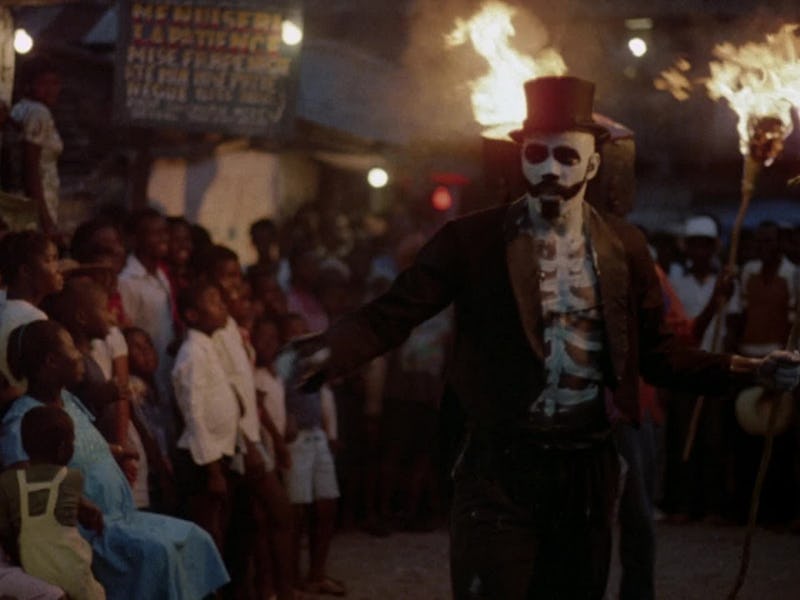Zombies Used to do More Than Eat Brains, and Wes Craven Showed Us How Scary Their Masters Could Be
Forget George Romero -- Craven's take on zombies recalls something more primal and real.

George Romero didn’t invent zombies. It may be hard to imagine the existence of zombie movies before his 1968 classic Night of the Living Dead, since Romero did invent most of the modern tropes. But the term existed long before Romero came along, and older representations of zombies can be seen in vintage horror movies like Victor Halperin’s 1932 White Zombie and Jacques Tourneur’s 1943 I Walked With a Zombie. That’s the tradition that another master of horror was working in when he made his own contribution to the genre.
Wes Craven’s haunting, underrated 1988 film The Serpent and the Rainbow uses the term zombie early and often, but it’s not about an apocalypse of the undead in the vein of most modern zombie movies. Instead, it hearkens back to an earlier definition of zombie, as derived from Haitian folklore. These zombies don’t hunger for human flesh, they don’t decay, and they don’t need to be shot through the head to be killed. They’re living humans who are almost catatonic, placed in a deathlike state and then revived as obedient puppets for a voodoo master.
The Serpent and the Rainbow is loosely adapted from the 1985 nonfiction book by Harvard anthropologist Wade Davis, who traveled to Haiti to study ancient beliefs and practices related to zombies. Craven and screenwriters Richard Maxwell and Adam Rodman take plenty of liberties with Davis’ work, adding the kind of horror imagery that Craven is known for. The fictionalized version of Davis is Dr. Dennis Alan (Bill Pullman), whose specialty is studying traditional medicine in native cultures. He’s introduced meeting with a shaman in the Amazon, where he experiences strong hallucinations after ingesting a mysterious concoction.
Upon returning to Boston, Dennis is called to a meeting with the ominously named Biocorp, where an executive asks him, “What do you know about zombification?” Dennis’ former colleague casually mentions that Dennis trekked 200 miles through the Amazon while under the influence of the shaman’s drug, so he’s clearly the guy to hurtle himself unthinkingly into dangerous situations for the sake of knowledge. Biocorp wants to send him to Haiti to discover the secret of creating zombies, which they believe could be used to produce a powerful medical anesthetic.
Dennis teams up with a local physician to fulfill their zombie needs.
It takes no convincing for Dennis to agree to the assignment. His consistent recklessness could be attributed to clueless American overconfidence or academic single-mindedness, and it’s probably a combination of the two. The Serpent and the Rainbow doesn’t entirely avoid exoticizing a foreign culture, but Craven treats Haiti and the voodoo religion with far more respect than might be expected from a sensational horror movie. For much of its running time, The Serpent and the Rainbow is more political drama than horror, as Dennis teams up with local physician Dr. Marielle Duchamp (Cathy Tyson) and attempts to procure some of the substance used to create zombies.
If anything, Dennis seems to be suffering from PTSD after his experience in the Amazon, and he’s plagued by disturbing nightmares. This allows Craven to indulge in the grotesque while keeping the characters’ waking lives more grounded in reality. Eventually, the lines blur, as Dennis plunges further into the voodoo underground and locates a man who was declared dead seven years earlier but returned as a supposed zombie. From there, he finds a local operator who claims to have the recipe for the zombification powder, which Dennis agrees to acquire for the shockingly low price of $1,000. Surely Biocorp has a bigger budget than that.
Dennis’ nightmares let Craven indulge his horror side.
Zombies aren’t the villains in The Serpent and the Rainbow; they’re pitiful figures who pose no real threat. The zombie whose existence caught Biocorp’s attention is a lonely vagrant who spends his time wandering through the cemetery where he was once buried. The real villain is Dargent Peytraud (Zakes Mokae), a commander in the paramilitary forces of dictator Jean-Claude Duvalier.
The movie is set against the real-life backdrop of Duvalier’s downfall, and was shot on location amid actual unrest in Haiti. That lends verisimilitude to the story, and Craven acknowledges Dennis’ potential position as an American imperialist. “This isn’t Grenada,” Peytraud warns Dennis, although he’s no humanitarian himself. He just doesn’t want Americans coming in to seize the power and control he has over his own people.
The real villain is one of Duvalier’s henchmen.
Mokae plays Peytraud as a terrifying megalomaniac who uses both voodoo and more modern means of intimidation and violence to maintain his position. The climactic battle between Dennis and Peytraud is a phantasmagorical combination of magic and brute force, with Craven obliterating the distinction between what Dennis is imagining and what’s actually going on. It’s completely divorced from Davis’ academic account, but it stays tethered to reality as Craven equates magical and political power during the uprising against Duvalier.
Whether they’re conjurings or hallucinations, Craven creates memorable, horrifying images, including a corpse bride with a snake emerging from her mouth and Dennis nearly drowning in a pool of blood as he’s buried alive. The horrors in The Serpent and the Rainbow don’t resemble Romero-style zombies, and they don’t resemble anything from Craven’s best-known work. But they’re primal and unsettling, all the more so for their origins in human cruelty and greed rather than something truly supernatural.
This article was originally published on